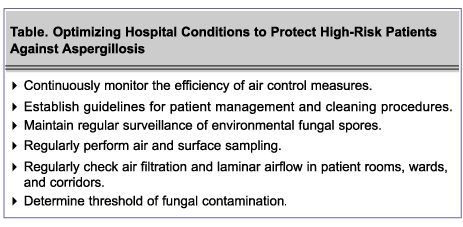 |
–Renée Grillot, PhD
ABSTRACT
Invasive aspergillosis is a leading cause of morbidity and mortality in immunocompromised individuals. Several factors underlie the development of this infection, including changes in the host and environmental conditions. Prevention is a major clinical challenge that must account for these factors. Patients who are at highest risk for invasive aspergillosis include those with profound and prolonged neutropenia, those who have had a stem-cell or solid-organ transplant, and those taking high-dose steroid therapy.
Air and food are the most evident sources of Aspergillus infection. Several investigative teams have used different typing methods to compare Aspergillus strains and genotype regarding hospital vs community acquisition of invasive aspergillosis, and have found that the infection is caused by a diversity of genotypes.
Hospitals can institute a number of preventive measures to protect high-risk patients, including continuous monitoring of air-control systems and regular surveillance of environmental fungal spores. Preventing delayed acquired aspergillosis outside of the hospital begins with advice to all immunocompromised patients to follow protective measures and minimize exposure.
(Advanced Studies in Medicine. 2003;3(1A):S12-S13)
|
Preventing invasive aspergillosis is a major clinical challenge; the infection develops as a result of several factors, including changes in the host, environmental conditions, the ubiquity of the Aspergillus species, and selective antifungal pressure. Invasive aspergillosis is a leading cause of morbidity and mortality in patients with hematologic malignancies, solid tumors, or acquired immune deficiency syndrome; organ transplant recipients; and other immunocompromised individuals and is associated with high mortality in a growing population of susceptible hosts. Thus, these factors must be considered to achieve effectiveness from any preventive strategy.
During the past decade, several working groups in Europe have explored the issues involved in preventing aspergillosis and have drafted or are currently drafting recommendations for preventing or reducing the risk of Aspergillus infections.1 These groups include the European Group for Research on Biotypes and Genotypes of Aspergillus fumigatus (EBGA network); the Mycology Study Group of the French Society of Clinical Hematology; the Group for Research of Fungal Infections, a group of hospitals in France; and the French Society of Hospitals and Hygiene, which organized a consensus conference in Paris in 2000 specifically to draft recommendations for prevention.2
At-Risk Patients
An important aspect of prevention is targeting the appropriate population. In invasive aspergillosis, that population includes those who are at highest risk–applying preventive measures to all with the expectation that the risk will drop to zero is unrealistic.
Immunocompromised individuals are at high risk for invasive aspergillosis. A recent report from the consensus conference reiterated that the risk of infection is highest when there is profound and prolonged neutropenia (defined as <0.5 g/L for 2 weeks or 0.1 g/L regardless of duration); a patient has undergone hematologic stem-cell or solid-organ transplantation; a transplant recipient develops graft-vs-host disease or has a cytomegalovirus coinfection; and when a patient is taking high-dose steroid therapy.3
Acquisition of Aspergillosis
Aspergillus infection is most evidently spread through air and food, but other routes, such as the gastrointestinal tract, should not be ignored as possible vehicles of transmission. In the hospital setting, the most common route of infection is the inhalation of airborne conidia of Aspergillus species.4 Less common, but by no means rare, is fungal contamination of food served in the hospital. There is some controversy as to whether contaminated water systems are responsible for nosocomial or community aspergillosis, but evidence supporting water as a source may be forthcoming.1
With regard to hospital vs community acquisition of aspergillosis infection, several teams, including the EBGA network, have used different typing methods during the past decade to fingerprint and compare Aspergillus strains and genotypes. Thus far, 8 teams from 6 European countries have isolated 703 well-documented strains from 112 patients and numerous genotypes.
The EBGA group isolated 52 strains from 12 neutropenic patients with invasive aspergillosis. In 9 of these patients, the infection was caused by more than 1 genotype.5 Similarly, the same group isolated 44 Aspergillus strains from 8 patients who had received lung transplants, and found a great diversity of genotypes.6 Thus, the occurrence of invasive aspergillosis does not depend on a particular genotype.
Although molecular investigation may provide valuable information in nosocomial invasive aspergillosis, it generally provides little useful information when clusters or sporadic cases of infection from A fumigatus occur.
Protecting High-Risk Patients
Hospitals can institute a number of preventive measures to protect high-risk patients, especially neutropenic patients, against nosocomial aspergillosis (Table).
Preventing delayed acquired aspergillosis outside of the hospital setting is more difficult. An important line of defense, however, is to advise all immunocompromised patients to follow protective measures and minimize exposure.

REFERENCES
- Gangneux JP, Bretagne S, Cordonnier C, et al. Prevention of nosocomial fungal infection: the French approach. Clin Infect Dis. 2002;35:343-346.
- Consensus conference: Preventing the risk of Aspergillus infection in immunocompromised patients. Bull Cancer. 2001;88:589-600.
- Ribaud P, Chastang C, Latgè JP, et al. Survival and prognostic factors of invasive aspergillosis after allogeneic bone marrow transplantation. Clin Infect Dis. 1999;28:322-330.
- Warnock DW, Hajjeh RA, Lasker BA. Epidemiology and prevention of invasive aspergillosis. Curr Infect Dis Rep. 2001;3:507-516.
- Bertout S, Renaud F, Barton R, et al. Genetic polymorphism of Aspergillus fumigatus in clinical samples from patients with invasive aspergillosis: investigation using multiple typing methods. The EBGA network. J Clin Microbiol. 2001;39:1731-1737.
- Symoens F, Bertout S, Piens MA, et al. A longitudinal follow-up of lung transplant recipients infected with Aspergillus: a study of genetic polymorphism of A fumigatus. EBGA network.
J Heart Lung Transplant. 2001;20:970-978.
*Based on a presentation given by Prof Grillot at the 12th European Congress of Clinical Microbiology and Infectious Diseases.
Address correspondence to: Renée Grillot, PhD, Parasitologie-Mycologie Médicale, Centre Hospitalier Universitaire et Université Joseph Fourier, BP 217, 38043 Grenoble Cedex 9, France.
Volume 3, Number 1A - January 2003
This CME Expires on January 15, 2005; no tests will be accepted after this date.
This course is accredited by
Johns Hopkins University School of Medicine Advanced Studies in Medicine
|
 |

